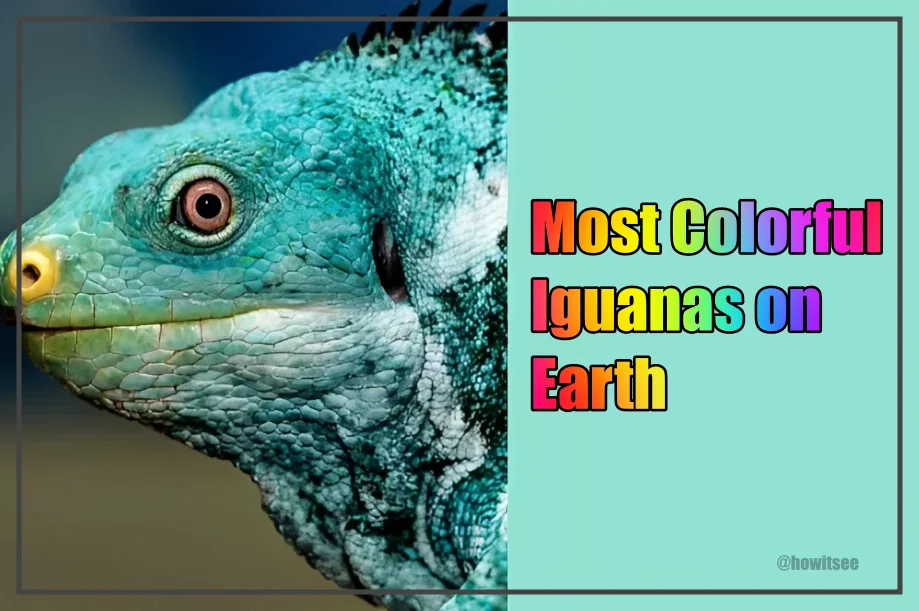We are back with another article on animals. I want to ask, What comes to mind when you hear the word Iguana? Maybe something large, usually brown, looks like Komodo dragons, right? But they are more than that. They vary in color, size, shape, habitat, etc., making them a fascinating and diverse group of animals. In this article, we will discuss these fascinating, colorful iguanas. Here is the list of the 15 most colorful iguanas found in nature.
15 Most Colorful Iguanas
1. Rhinoceros Iguana
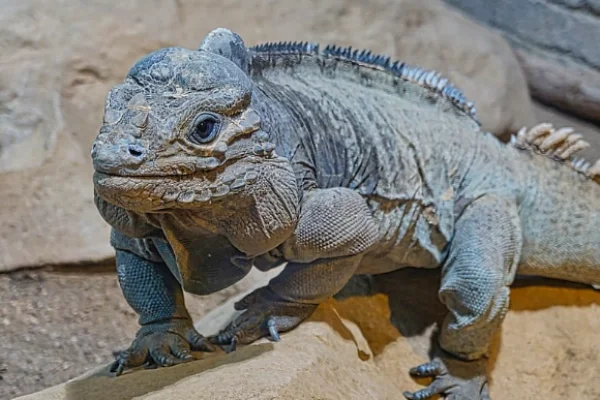
| Scientific name | Cyclura cornuta |
| Size | 24-54 inches |
| Location | Caribbean Island Hispaniola |
| Habitat | Dry forests, Costal terraces etc. |
We will start our list with these fascinating iguanas. Cyclura cornuta is commonly known as the rhinoceros iguana on the Caribbean island of Hispaniola.
They are heavy-bodied with flattened tails. They are gray to brown, with an average body size of 24–54 inches. Females can easily distinguish themselves from males. Males are large than females and have more prominent horns.
2. Española Marine Iguana
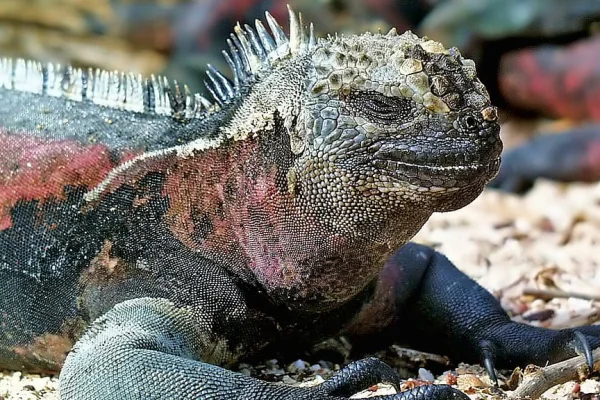
| Scientific name | Amblyrhynchus cristatus |
| Size | body size – 12 to 56 cm
tail length- 17 to 84 cm |
| Location | Galapagos Island |
| Habitat | Marshes, Mangrove swamps, and beaches |
Only iguanas adapt to the marine environment. According to the IUCN Red List, they are considered vulnerable animals. This colorful iguana finds on the Galapagos Islands. They have blunt snouts and flattened tails that help them forage for algae underwater.
They can change their color according to the season. Sneezing out the excessive salt from their nasal glands is their distinctive characteristic. According to research, they evolved from land iguanas and adapted to marine environments for better survival.
3. Lesser Antillean Iguana

| Scientific name | Iguana delicatissima |
| Size | 40- 80 cm |
| Location | Lesser Antilles, Anguilla, St.Eustatius, Guadeloupe, Dominica, and Martinique |
| Habitat | Rainforests, mangroves |
Iguana delicatissima, or Lesser Antillean iguana, is the endemic species of the Lesser Antilles. Let’s talk about appearance. They are grayish with some green splotches underside and have pale yellow ivory scales on their heads.
These critically endangered iguanas are usually solitary and only interact with each other during the breeding season. They are herbivores and compete with green iguanas for resources.
4. Grand Cayman Blue Iguana
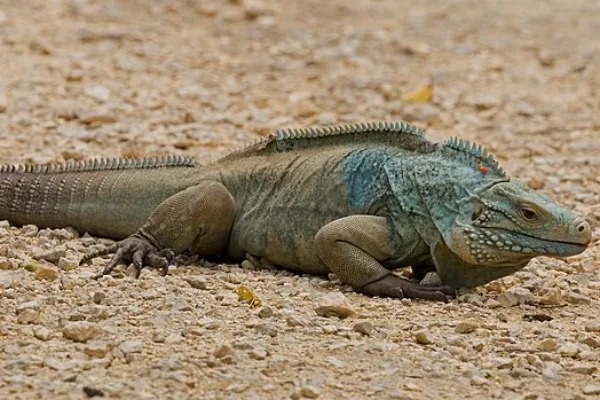
| Scientific name | Cyclura lewisi |
| Size | 1.5 m |
| Location | Island of Grand Cayman |
| Habitat | Xerophytic Shrubland, dry forests |
This handsome Grand Cayman Blue Iguana is known for its striking blue appearance, which makes it unique and different from other iguanas. These herbivorous iguanas are endemic to the island of Grand Cayman.
They dramatically show sexual dimorphism. Females are smaller than males and have short femoral pores on their thighs. Their mating occurs in May and June.
5. Galapagos Land Iguana

| Scientific name | Conolophus subcristatus |
| Size | 0.9-1.5 m |
| Location | Galapagos island |
| Habitat | Dry lowlands |
This Galapagos Island endemic iguana is famous for its large size and remarkable yellow appearance. Charles Darwin defines them as ugly animals. They are one of the most giant lizards in the world and can attain a body length of 0.9–1.5 m.
They have an average lifespan of 60–69 years. It sometimes interbreeds with marine iguanas, resulting in a hybrid iguana. They show a beautiful symbiotic relationship with Darwin finches.
6. Galapagos pink Iguana
| Scientific name | Conolophus marthae |
| Size | Body length- 47 cm
tail length- 61.4 cm |
| Location | Northern Isabela Island of the Galápagos Islands |
| Habitat | Dry lowland |
Have you ever heard of pink lizards? Sounds interesting, right? The pink iguana, or Galápagos rosy iguana, is the common name of Conolophus marthae, as it has a pink body with some black markings.
They were described in 2009 as a new species. They are considered critically endangered because of their small population size. You can find these amazing creatures on the Wolf volcano of Northern Isabela Island in the Galapagos Islands.
7. Jamaican Iguana
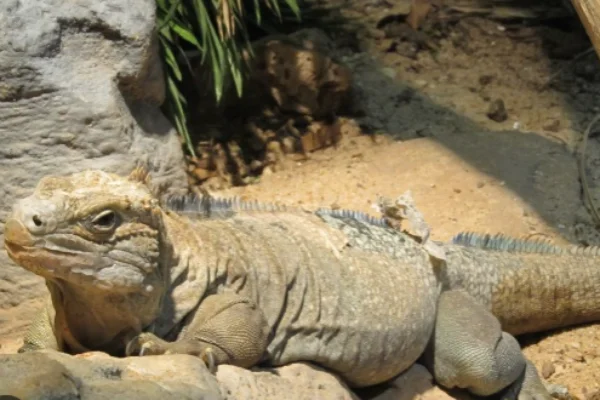
| Scientific name | Cyclura collei |
| Size | 14.9-16.9 inches |
| Location | Jamaica |
| Habitat | Dry, rocky, limestone forest areas |
The Jamaican iguana is the rarest lizard in the world. It was thought to be extinct in 1948 but is now considered critically endangered. They are green to blue, with dark green shoulders.
Like all other iguanas, they are herbivores and primarily feed on flowers, fruits, etc. The introduction of small Asian mangoes caused a reduction in their population. They are large, with a body size of 14.9 to 16.9 inches.
8. Lau banded Iguana
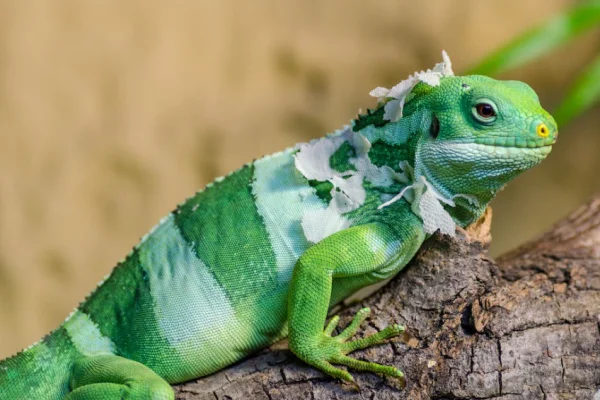
| Scientific name | Brachylophus fasciatus |
| Size | 60 cm |
| Location | Lau Islands of the Fijian archipelago |
| Habitat | Lowland |
Brachylophus fasciatus or Lau banded iguana, is an endangered iguana species endemic to the Lau Islands. Males are very different from females. Males are green in color with two or more white bands, whereas females are plain green.
They are oviparous and breed in November. The government of Fiji considers them a national treasure as their pictures are everywhere, like on stamps, phone nooks, railway tickets, etc.
9. Yucatan Spiny-Tailed Iguana
| Scientific name | Ctenosaura defensor |
| Size | 4-9 inches |
| Location | Mexico |
| Habitat | Semi-arid regions |
Ctenosaura defensor, or Yucatan spiny-tailed iguana, is only found in northern Yucatan, Mexico. They are the most colorful and beautiful of all lizards. Their coloration is quite attractive and unique; they are gray with red and black markings or banded patterns.
They are not good pets, as their management is not an easy task to do. According to studies, they can live up to 15 years in captivity. They are fast runners and can run up to 34 km/h.
10. Northern Bohemia Iguana
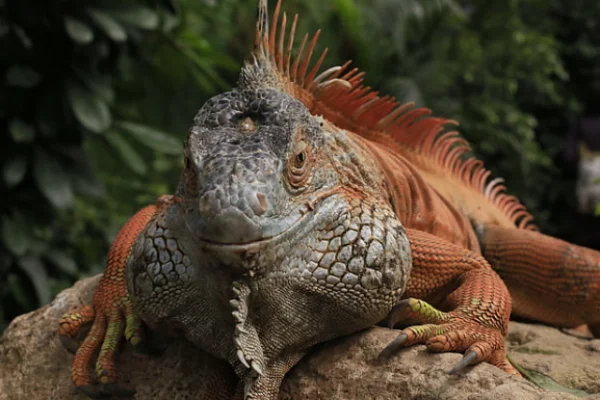
| Scientific name | Cyclura cychlura |
| Size | 150 cm |
| Location | Southwestern Bahamas |
| Habitat | tropical dry forest, pine barrens, coastal scrub, mangrove, and beach strand |
Dark gray to black coloration with yellowish-green scales makes the northern bohemian iguana distinct. You can find these iguanas on Andros and Exuma Islands in the Bahamas.
They are sexually dimorphic. Females are shorter than males. Their breeding season comes in early spring, and males of this species become more bright than at other times.
These iguanas used to be eaten by the Bahamas people. Now, to stop the exploitation of this species, the Bahamas government has initiated many plans.
11. Fiji Crested Iguana
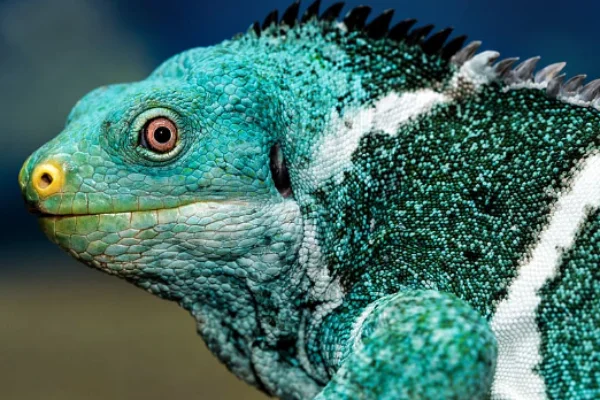
| Scientific name | Brachylophus vitiensis |
| Size | 75 cm |
| Location | Island of the Fijian archipelago |
| Habitat | Shades of trees |
These beautiful green iguanas with three pale or white bands have a very distinct appearance. Brachylophus vitiensis, also known as the Fiji crested iguana, has spiny crests on its spines and is found on the Fijian archipelago island.
They are often mistaken for Lau banded iguanas because of their similar appearance. These critically endangered species inhabit tropical dry forests.
12. Cuban Rock Iguana

| Scientific name | Cyclura nubila |
| Size | 40 cm |
| Location | Cuba |
| Habitat | Dead trees, hollow logs, limestone crevices |
The Cuban rock iguana, Cyclura nubila, is one of the largest lizards in the Caribbean. Cuban rock iguana males are dark gray to red, whereas females are olive green with strips. They are herbivores and primarily eat pear, purslane, etc.
Researchers also observe cannibalism in this species of iguana. Males are very aggressive, and one can find them defending each other for females.
Studies show that they lay eggs in the same nest every year. You can find these vulnerable iguanas in Cuba, primarily inhabiting dead trees, hollow logs, and limestone crevices.
13. Desert Iguana
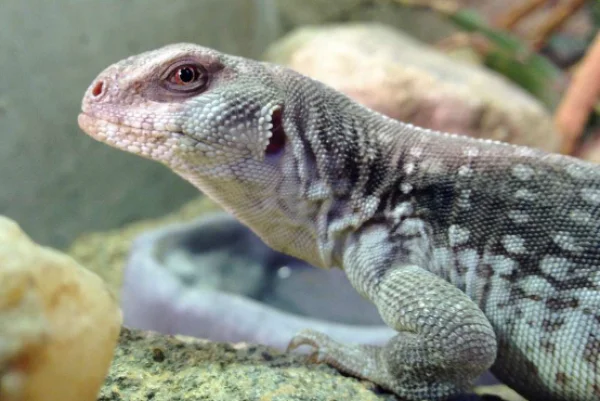
| Scientific name | Dipsosaurus dorsalis |
| Size | 41-61 cm |
| Location | Sonoran and Mojave deserts of the United States and Mexico |
| Habitat | desert scrubland |
These medium-sized desert iguanas are gray to cream in color with brown reticulate patterns. As their name indicates, they usually prefer desert scrublands and tropical deciduous forests.
They are adapted to high temperatures and can easily survive in these hot lands. Breeding usually occurs in May and June. These desert dwellers commonly inhabit the Sonoran and Mojave deserts of the United States and Mexico.
They are primarily herbivores but also eat insects and their own fecal matter. Their sides become pink during mating season, which makes them unique. And about body length, they are 41 to 61 cm long.
14. Northeastern Spiny Tail Iguana
| Scientific name | Ctenosaura acanthura |
| Size | 1-1.4 m |
| Location | Mexico and Guatemala |
| Habitat | Prefer Rocky habitat |
They are herbivores and usually inhabit human habitation. Males are large, with an average size of 1–1.4 mm.
15. Chuckwallas

| Scientific name | Sauromalus hispidus |
| Size | 44- 64 cm |
| Location | Guardian Angel Island in the Gulf of California |
| Habitat | Rocky habitat |
The Angel Island Chuckwalla, or the spiny Chuckwalla, are lizards found only on Guardian Angel Island in the Gulf of California. They are large, with an average body size of 64 cm and a weight of 1.4 kg.
They are primarily herbivores but eat insects also sometimes. It uses various ways to communicate, like head hobbing, pushups, and mouth gaping.
In conclusion, we know that these iguanas have a colorful appearance and distinctive characters. As you saw in the article, the IUCN red list categorizes most of the iguana species as endangered.
They are harmless to humans. Therefore, if you ever encounter one, you should appreciate these rare, beautiful creatures.
Also Read:

Being a zoology student I’m always been fascinated toward animals especially insects. I love to do research and learn about different animals. As a writer I want to share my thoughts about nature through my articles. Apart from this you can find me exploring the new places and voice notes.
